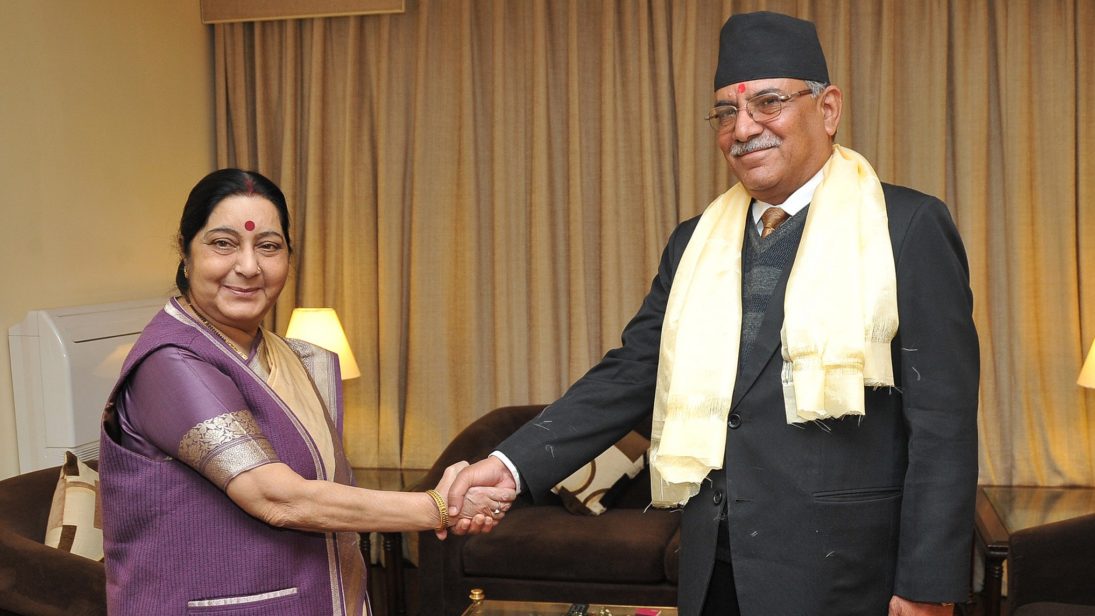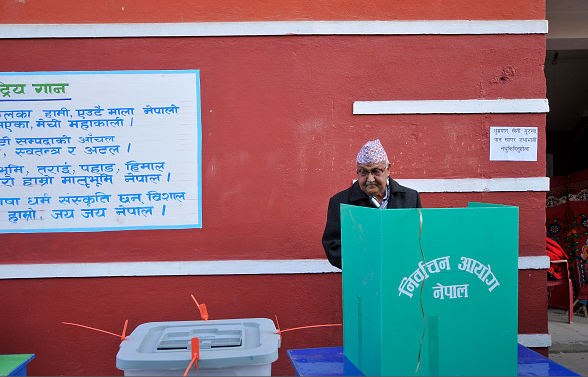
External Affairs Minister Sushma Swaraj’s two-day visit to Kathmandu earlier this month was a clear sign of India’s desperate attempt to mend fraying ties with Nepal. However, it was viewed by many as another Indian ploy to intervene in Nepal’s internal affairs at a time when the Communist Party of Nepal-(United Marxist Leninist) (CPN-UML) and its electoral ally, the Communist Party of Nepal-Maoist Centre (CPN-Maoist Centre), are discussing the modalities of forming government.
To maintain political stability in Nepal, leaders should be cautious not to be swayed by the carrots India gives while trying to bring the parties it favors into power. Nepali leaders should not be hypnotized by India’s recent charm offensive but demonstrate their commitment to a democratic process of government formation and conduct foreign affairs independently.
Recent Bilateral Tensions and the China Factor
Nepal and India have enjoyed close linkages historically. In fact, New Delhi even brokered a peace agreement between the Nepali government and the Maoist insurgents in 2006. However, their relationship has been on the decline since India employed coercive diplomacy to pressure Nepal to amend its constitution in 2015 by invoking what the Nepali government called an “unofficial blockade” of the border. Relations reached a new low with the rise of anti-India sentiment among the Nepali public. Following the blockade, Nepal began to forge closer ties with its northern neighbor: China. Further, the CPN-UML’s victory in the recent federal elections, a party allegedly labeled pro-Chinese, caused significant discomfort in New Delhi.
The rift between New Delhi and Kathmandu widened during the tenure of Prime Minister K. P. Oli. He refused to succumb to Indian pressures of a blockade as a way of pushing the Nepali government to amend its constitution, which India had only “noted” and not accepted. India believed that the constitution was discriminatory against the Madhesis, who are Nepalis of Indian origin living close to the Indo-Nepali border. However, India’s tactics backfired because under Oli’s watch, Nepal began to act on its own by defending Nepali sovereignty and putting the country’s national interests before petty political gains. Additionally, Oli began courting China and expressed disdain over India meddling in Nepal’s internal affairs.
Moreover, Oli even signed an agreement with China that allowed Nepali trade to pass through Chinese land routes and ports, mitigating Nepal’s dependence on India for overland trade. Domestically, CPN-UML’s nationalist position helped Oli and his broader left alliance gain a two-third majority in the recent provincial and federal elections. Regionally, while the Indian media was unsettled by the result, the Chinese media welcomed it and was hopeful that the incoming government in Kathmandu would further enhance economic cooperation with Beijing. Though, it is critical to note here that Oli and his party members have maintained that they are neither pro-China nor anti-India and that both neighbors are equally important for Nepal’s prosperity.

India’s Recent Attempts to Woo Nepal
Oli’s government, which was formed in October 2015 with the support of the Maoist Centre, was toppled after the latter withdrew from the coalition in 2016. Oli blamed India for his political downfall and thus, his relationship with the Indian government soured. Given this context, Swaraj’s two-day visit is reflective of the eagerness with which New Delhi is trying to mend ties with Nepal and restore the relationship to pre-blockade levels before the incoming government is sworn in. India appears to be departing from its previous stance and has acknowledged constitutional amendment to be Nepal’s internal matter. Further, Indian Prime Minister Narendra Modi even telephoned Oli twice after the election acknowledging him as the next prime minister before he sent Swaraj to Kathmandu to deliver a “special political message.”
Although the blockade represents a blemish on the history of Nepal-India relations and will remain in the public memory for the foreseeable future, the Nepali political leadership has also made overtures to India post-election in its efforts to maintain political pragmatism. Oli’s letter of congratulation to Modi on India’s Republic Day is a case in point. Swaraj’s visit also lifted the Indian government’s ban on ginger imports from Nepal.
What Nepal’s Calculus Should Be
Modi’s recent warming up to Oli indicates New Delhi’s desire to remain Nepal’s primary ally. In this regard, Swaraj’s visit serves as a course correction of the damage that had been done in the recent past. Further, since both India and China are vying for greater influence in South Asia, India is also fearful of Nepal increasingly falling into China’s orbit. India is hopeful that this visit would change that to some extent.
However, such a myopic view does not befit the world’s largest democracy. Nepal is free to engage with both of its neighbors without having to worry about what the other country might think. If India is anxious about such engagement, then perhaps such anxiety stems from pure insecurity that could ultimately lead to policies that would only backfire. On the other hand, Nepal should try to balance both its neighbors in this geostrategic rivalry because when two elephants fight, it is the grass that gets trampled.
In spite of many hurdles, internal and external, Nepali political leadership has brought the constitution and peace process to near completion. The right course of action would be to follow the electoral mandate, which is clearly in favor of the CPN-UML and CPN-Maoist Centre. This demands that Nepal carefully carve its foreign policy in a way that does not displease either of its neighbors, but most importantly, keep its sovereignty and interests as the central focus.
***
Image 1: MEAphotogallery via Flickr
Image 2: NurPhoto via Getty


